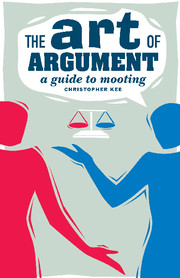Book contents
- Frontmatter
- Contents
- Preface
- Acknowledgments
- Part 1 Making the most of a moot
- 1 Introduction
- 2 You've made the team – what next?
- 3 Being part of a team
- 4 Building an argument
- 5 Written documents
- 6 Oral submissions
- 7 Practice moots
- 8 The competition itself
- 9 After it's all over
- Part 2 References and resources
- Part 3 International moots
- Index
2 - You've made the team – what next?
Published online by Cambridge University Press: 05 June 2012
- Frontmatter
- Contents
- Preface
- Acknowledgments
- Part 1 Making the most of a moot
- 1 Introduction
- 2 You've made the team – what next?
- 3 Being part of a team
- 4 Building an argument
- 5 Written documents
- 6 Oral submissions
- 7 Practice moots
- 8 The competition itself
- 9 After it's all over
- Part 2 References and resources
- Part 3 International moots
- Index
Summary
BEFORE YOU BEGIN
Good preparation is the key to success in mooting competitions. This book aims to give you an insight into issues you are likely to encounter throughout the process. This means that you can begin preparing for all aspects now, rather than have problems descend on you at a time when your efforts are better spent refining your oral presentations.
Timing and commitment
We have already noted that participation in a moot competition involves intensive training. With intensive training comes commitment. A team will set its own level of commitment, but if you want your team to perform at its best, every member needs to be highly committed to ensure the team's success.
Participating in an international mooting competition involves an extraordinary amount of time. It takes time to prepare. It takes time to travel overseas and participate. All of this needs planning. In particular, you need to think about what impact it will have on other commitments you may have, such as paid employment, other studies, and family relationships. Paid employment is potentially the most difficult to accommodate.
The time of year when the moot actually takes place needs careful consideration when you are deciding whether or not to participate. For example, a moot that takes place in the early part of the year will require most students in the southern hemisphere to work solidly throughout their summer break. There are advantages and disadvantages to this.
- Type
- Chapter
- Information
- The Art of ArgumentA Guide to Mooting, pp. 7 - 12Publisher: Cambridge University PressPrint publication year: 2007



